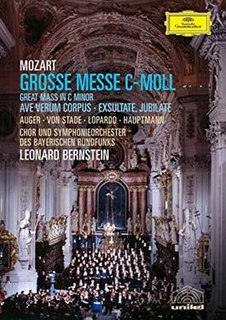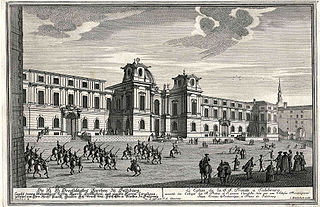 W
WWolfgang Amadeus Mozart (1756–1791) composed several masses and separate mass movements. Mozart composed most of his masses as a church musician in Salzburg:Masses for regular Sundays or smaller feasts belonged to the missa brevis type. In the context of Mozart's masses brevis (short) applies primarily to the duration, i.e. the whole mass ceremony took no longer than three quarters of an hour. Instrumentation for such a missa brevis would usually be limited to violins, continuo, and trombones doubling the choral parts of alto, tenor and bass. The generic name for longer masses was missa longa, for more solemn and festive occasions. Additional instruments include oboes, trumpets, timpani, and for some of them also French horns. Instead of treating each part of the mass liturgy in a continuous rendition of the text, there are repeats, fugues, and subdivisions in several movements with separate orchestral introductions. Missa longa is usually synonymous with missa solemnis, however in Mozart's Salzburg, a hybrid brevis et solemnis seems to have existed, short in duration, but nonetheless for the more festive occasions, for example including a more elaborate orchestration than the usual missa brevis.
 W
WThe Krönungsmesse, composed in 1779, is one of the most popular of Wolfgang Amadeus Mozart's 17 extant settings of the Ordinary of the Mass. It can be classified as either a Missa brevis or a Missa solemnis because although it includes all the sections of the Ordinary, it is relatively short.
 W
WGreat Mass in C minor, K. 427/417a, is the common name of the musical setting of the mass by Wolfgang Amadeus Mozart and considered one of his greatest works. He composed it in Vienna in 1782 and 1783 after his marriage when he moved to Vienna from Salzburg. This large-scale work, a missa solemnis, is scored for two soprano soloists, a tenor and a bass, double chorus and large orchestra. It remained unfinished, missing large portions of the Credo and the complete Agnus Dei.
 W
WMozart: Grosse Messe c-moll KV 427 is an 86-minute live video album of Wolfgang Amadeus Mozart's Christian vocal works Great Mass in C minor, Ave verum corpus and Exsultate, jubilate, performed by Arleen Auger, Cornelius Hauptmann, Frank Lopardo, Frederica von Stade, the Bavarian Radio Symphony Chorus and the Bavarian Radio Symphony Orchestra under the direction of Leonard Bernstein. Deutsche Grammophon issued it on VHS video cassette, Laserdisc and DVD, and also released audio cassette and CD versions of its soundtrack.
 W
WThe Missa brevis No. 9 in B-flat major by Wolfgang Amadeus Mozart, K. 275/272b, was probably written before September 1777 for Salzburg. The mass is scored for SATB soloists, SATB choir, violin I, violin II, 3 trombones, string bass, and organ.
 W
WThe Missa solemnis in C major, K. 66, is a mass composed by Wolfgang Amadeus Mozart in 1769. It is scored for SATB soloists and choir, violins I and II, viola, 2 oboes, 2 horns, 2 clarini, 2 trumpets and basso continuo.
 W
WThe Missa in honorem Sanctissimae Trinitatis in C major, K. 167, is a mass composed by Wolfgang Amadeus Mozart in June 1773. It is scored for SATB choir, violin I and II, 2 oboes, 2 clarini, 2 trumpets, timpani and basso continuo.
 W
WThe Sparrow Mass is a mass in C major K. 220/196b, Mass No. 9, Missa brevis No. 5, composed by Wolfgang Amadeus Mozart in 1775 or 1776 in Salzburg. The mass is sometimes termed a missa brevis et solemnis, because it is short in a simple structure as a missa brevis, but festively scored like a missa solemnis with brass and timpani in addition to four soloists, strings and organ. It was possibly first performed on 7 April 1776 in a mass for Easter at the Salzburg Cathedral. The nickname is derived from violin figures in the Hosanna which resemble bird chirping.
 W
WThe Credo Mass in C major, K. 257, is a mass composed by Wolfgang Amadeus Mozart in 1776. It is scored for SATB soloists, SATB choir, violin I and II, 2 oboes, 2 clarini, 3 trombones colla parte and basso continuo.
 W
WThe Missa brevis No. 7 in C major, K. 258, is a mass composed by Wolfgang Amadeus Mozart in 1776. It is scored for SATB soloists, SATB choir, violin I and II, 2 oboes, 2 clarini, 3 trombones colla parte, timpani and basso continuo.
 W
WThe Missa brevis No. 8 in C major, K. 259, is a mass composed by Wolfgang Amadeus Mozart in 1776. It is scored for SATB soloists, SATB choir, violin I and II, 2 oboes, 2 clarini, 3 trombones colla parte, timpani and basso continuo.
 W
WThe Missa longa in C major, K. 262/246a, is a mass composed by Wolfgang Amadeus Mozart in May 1776. Other sources claim it was composed in May 1775. It is scored for SATB soloists, SATB choir, violin I and II, 2 oboes, 2 horns, 2 clarini, 3 trombones colla parte, timpani and basso continuo.
 W
WThe Missa solemnis in C major by Wolfgang Amadeus Mozart, K. 337, was written in 1780 for Salzburg. It was Mozart's last complete mass. The mass is scored for soloists, choir, 2 oboes, 2 bassoons, 2 trumpets, 3 trombones, strings and organ, the latter supplying figured bass for most of the duration.
 W
WThe Missa solemnis in C minor, K. 139/47a, is a mass composed by Wolfgang Amadeus Mozart in the summer of 1768 in Vienna. It is scored for SATB soloists, SATB choir, violin I and II, 2 violas, 2 oboes, 2 trumpets, 2 clarini, 3 trombones colla parte, timpani and basso continuo.
 W
WThe Missa brevis in D major, K. 194/186h, is a mass composed by Wolfgang Amadeus Mozart and completed on 8 August 1774. It is scored for SATB soloists, SATB choir, violin I and II, 3 trombones colla parte, and basso continuo.
 W
WThe Missa brevis in D minor, K. 65/61a, is a mass composed by Wolfgang Amadeus Mozart and completed on 14 January 1769. It is scored for SATB soloists and choir, violin I and II, 3 trombones colla parte, and basso continuo.
 W
WMozart's Mass in G major, K. 49/47d), is his first full mass. It is a missa brevis scored for SATB soloists and choir, violin I and II, viola, and basso continuo.
 W
WThe Missa brevis in G major, K. 140, K3 Anh. 235d, K6 Anh. C 1.12, was probably composed by Wolfgang Amadeus Mozart shortly after returning to Salzburg, in March 1773, from his third trip to Italy.
 W
WThe Requiem in D minor, K. 626, is a requiem mass by Wolfgang Amadeus Mozart (1756–1791). Mozart composed part of the Requiem in Vienna in late 1791, but it was unfinished at his death on 5 December the same year. A completed version dated 1792 by Franz Xaver Süssmayr was delivered to Count Franz von Walsegg, who commissioned the piece for a requiem service to commemorate the anniversary of his wife's death on 14 February.
 W
WThe composition of Mozart's unfinished Requiem, K. 626, his last work, is surrounded by the following events.